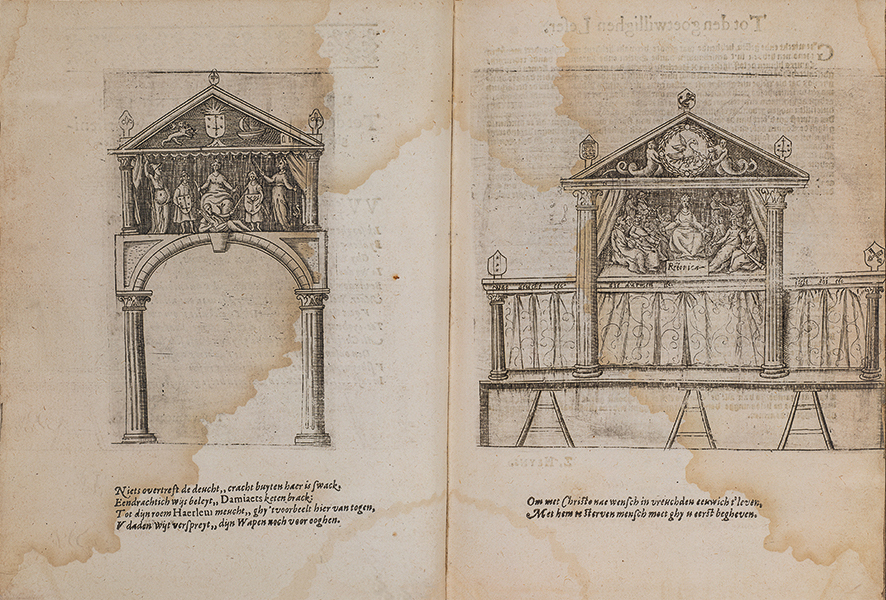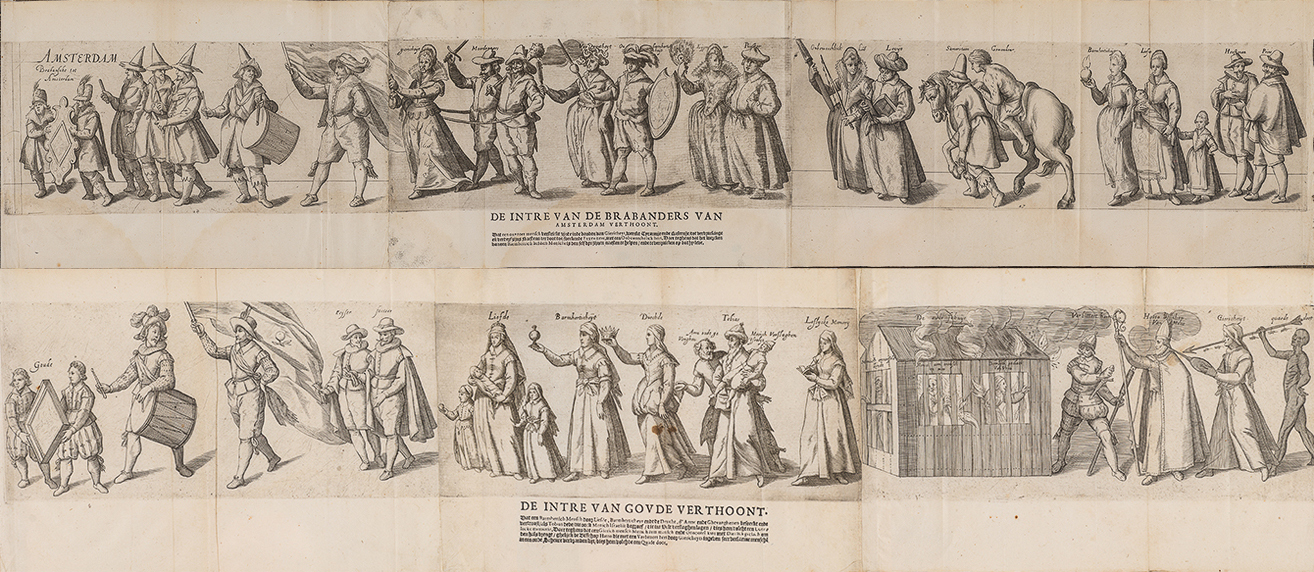Rare engravings
On Sunday 22 October 1606, twelve chambers of rhetoric took part in the Haarlem competition, organized by the local chamber De Pellicanisten (The Pelicans), also known by their motto ‘Trou moet Blycken’ (Fidelity must be Proved). This festive competition between the poetry societies lasted ten days and set out to encourage the audience to be generous, as the event was linked to a lottery intended to raise money to build a new oudemannenhuis (old men’s home) in the city. Consequently, this competition was centred around mercifulness and charity and their opposites.
Zacharias Heyns, the factor (literary leader) of the chamber Het Wit Lavendel (The White Lavender), attended this event and also documented it. Heyns published his report himself under the title Const-thoonende iuweel (1607). This is the most comprehensive and most impressive report on a rhetoricians’ competition ever published. Given that it includes thirteen detailed engravings illustrating the festive entrance of the chambers of rhetoric as well as the usual poems and play scripts. Imagery of this kind is extremely rare. You can request and glance through a complete – and therefore rare – copy of this report at Special Collections at the University of Groningen Library.
For the entrance, De Pellicanisten chose, as was customary, a theme: “Wat deucht oyt wracht, een Mensch barmhertich, liefdich goet, / En wat verschricklijck quaet, een gierich Mensch onvroet” (What good a merciful, kind Person, /And what terrible evil a mean and foolish Person has ever wrought). This meant that the costumes and props for the entrance not only had to look good, but also be able to convey meaning.
The majority of the chambers opted for an allegorical approach, portraying virtues and vices through personifications. All of them chose to depict the moral consequences of virtuous and avaricious actions as well; the two extremes of these were salvation in heaven and damnation in hell. The conclusion was obvious: be merciful, not mean.

The processions entered through the triumphal arch. First came the drummers and standard-bearers, followed by the board members of the chamber and finally, a row of characters. On the stage they repeated their entrance, with an explanation in verse form.

A historical city account reveals that detailed drawings of the entrances were made, including an indication of the colours of the costumes: “Betaelt Wijert Claesz., schilder, die somme van 10 guldens uyt saecke dat hij op papijer getrocken ofte geconterfeijt heeft nae ’t leven den intree van de rethorijckers deser stede, […] ende noch geteijckent de couleuren ofte bij geschrifte gestelt wat couleuren elcke personage gehadt heeft […]” (Wijert Claesz., a painter, was paid a sum of 10 guilders for having drawn or made a true picture on paper of the entrance of the chambers of rhetoric of this city […] and also for having drawn or written down which colours each character wore […]). The engravings of the entrance were probably based on these drawings.
These engravings are a unique source of knowledge on the allegorical stage clothing and props that the rhetoricians would use, since the characters in the procession came back later, wearing the same costumes, in a morality play. Not much is clear about the materials used, but the chaerte (invitation) states that the “opper-cleet” (the outer garment) was to be “oncostelick” (inexpensive). Evidently, the important thing was the effect and the design of the clothing; it was not about using the most expensive materials.
All of this demonstrates that Heyns’s report is a valuable source of imagery of the early seventeenth-century rhetoricians and their competitive nature in the Northern Netherlands. The Const-thoonende iuweel is a rare source which – literally – shows the ‘const’ (art) of the rhetoricians and therefore provides greater insight into literary competitions of this kind. Special Collections is certainly the right place for this rare complete copy.
The Haarlem competition did in fact achieve its charitable objective: the net proceeds of the 308,037 lottery tickets sold amounted to over 50,000 guilders. This was more than enough to build the planned oudemannenhuis. Currently, the Frans Hals Museum is housed in that building.
Literature
Bart Ramakers. ‘De “Const” getoond. De beeldtaal van de Haarlemse rederijkerswedstrijd van 1606.’ In Reindert Falkenburg, e.a. Hof-, staats- en stadsceremonies. Nederlands Kunsthistorisch Jaarboek 49 (1998): 128-183.
G.J. Jaspers. ‘Trou moet Blyeken te Haarlem en haar oude drukken in de Stadsbibliotheek.’ In De boekenwereld 8 (1991-1992): 154-169.
Wim Hummelen. De sinnekens in het rederijkersdrama. Groningen: Wolters, 1958.

